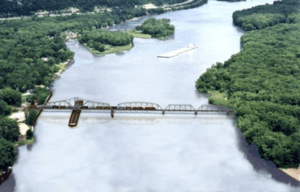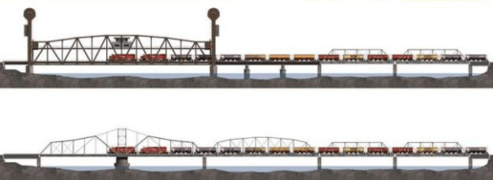La Crosse Rail Bridge
| La Crosse-La Crescent Canadian Pacific Railway, Main Channel Bridge | |
|---|---|
 | |
| Coordinates | 43°50′00″N 91°16′53″W / 43.8332°N 91.2813°WCoordinates: 43°50′00″N 91°16′53″W / 43.8332°N 91.2813°W |
| Carries | One track of Canadian Pacific Railway, shared with Amtrak |
| Crosses | Mississippi River |
| Locale | La Crosse, Wisconsin |
| Official name | Canadian-Pacific Rail Road Bridge #283.27 Tomah Subdivision, La Crescent, MN, Houston County |
| Other name(s) | L4-B |
| Maintained by | Canadian Pacific Railway |
| ID number | L4-B |
| Characteristics | |
| Design | Swing bridge |
| Total length | 1,042 feet (318 m) |
| Width | 20 feet (6 m) |
| Clearance below | 21.9 feet (7 m) |
| History | |
| Opened | Original structure, 1876 |
La Crosse Rail Bridge is a swing bridge that spans the Mississippi River between La Crescent, Minnesota and La Crosse, Wisconsin.
The original bridge was one of the first 15 bridges across the Mississippi River. It was designed and built in 1876 by Chicago, Milwaukee, St. Paul and Pacific Railroad.
Prior to the construction of any swing bridges, the Mississippi River connected the country north to south, but was an obstacle for those going east to west. The railroad relied on ferry boats to transport rail cars across the river into La Crosse, which cost a considerable amount of money and time. In addition, many of the ferry boats were unreliable because they had no fixed scheduled. In the early 1800s, it was difficult to construct bridges, as they needed to provide enough clearance for the abundance of steamboats on the river. In the winter months when the river froze over and boat traffic stopped, the railroad would lay down seasonal tracks across the ice and remove them by spring.
Then in 1856, the first swing bridge to span the river was constructed in Rock Island, Ill., to solve the problem. Only a few days after the bridge was opened, a steamboat crashed into it. Some people think it might have been on purpose because the steamboats did not care for these bridges. The boat and bridge caught on fire, and the steamboat owner sued for damages, claiming the bridge was a hazard to navigation. Fortunately for the railroad, it was defended in court by an Illinois lawyer: Abraham Lincoln.
Lincoln won the case for the railroad, arguing that a person has a much right to build a bridge to cross a river as another person has to travel up and down the water. This victory led to the construction of even more swing bridges, including the L4B.
Over the years, L4B has gone through many changes, with a major update in 1902 when it was reinforced with iron. The initial construction of L4B began in June 1876 and was completed five months later in November. At the time, the bridge cost $500,000 to build, but paid for itself in a few years, with the railroad saving $90,000 a year in river tolls.
The bridge is located over the west channel of the Mississippi River near Shore Acres and links to Minnesota Island. A second bridge connects Minnesota Island to the Wisconsin shore across the Black River. L4B, however, is located entirely on the Minnesota side of the river and is 1,050 feet, 11 inches long.
The swing span has a humpback truss, while the two adjoining spans are flat-top fixed through trusses. Amtrak's Empire Builder crosses this bridge.
What makes L4B unique is its swing feature. A section of the bridge swings on a pivot point, opening up two 150-foot- wide lanes for river traffic to pass through, similar to a gate. The bridge is operated from a tower and originally ran on steam power. Opening and closing the swing bridge takes about five minutes, which allowed the railroad to build a permanent track across the river to La Crosse without interfering with the towboats and barges that travel up and down the Mississippi.
River traffic has the right of way, and the swing bridge must even open for privately owned pleasure crafts or face fines from the Coast Guard, though it is speculated that the railroad would often take the fines over the cost of stopping a train.
The L4B has taken a significant amount of abuse over the years. The L4B is ranked fourth in most boat-related collisions out of 22 states, 7,500 miles of railway and 1,200 other bridges. One incident was as recent as July 22, 2011, when a barge clipped the side of the bridge and halted river traffic.
Proposed alteration
The Coast Guard has proposed alterations to the L4B. The proposed plan would remove the swing bridge and install a lift span and create a 65-foot clearance and open a 300-foot wide lane for the boats. The alterations would move the bridge opening away from the shore line to the center of the channel. The Coast Guard has dropped plans to alter the bridge.[1]
 A new 300 foot wide lift span in the center of the main channel.
A new 300 foot wide lift span in the center of the main channel. New 300' lift span with two new piers added
New 300' lift span with two new piers added New 300' lift span in place of swing bridge
New 300' lift span in place of swing bridge
Gallery
See also
References
- Costello, Mary Charlotte (2002). Climbing the Mississippi River Bridge by Bridge, Volume Two: Minnesota. Cambridge, MN: Adventure Publications. ISBN 0-9644518-2-4.
External links
| Wikimedia Commons has media related to La Crosse Rail Bridge. |
- Letter from the Secretary of War Transmitting a Report Locating a Bridge Across the Mississippi River at La Crosse, Wisconsin
- Historic swing bridge an important cross country link, By Clay Schuldt / For the Houston County News

